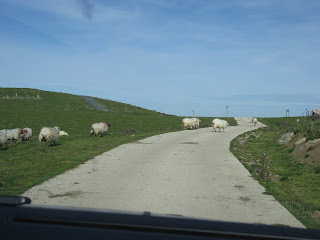




We recently attempted our first hike in the Pyrenees, the mountain range that is just south of us. It is a large range that divides France and Spain, and goes from the Atlantic to the Mediterranean coast. It was the first time that our hiking boots came out of the box that they traveled here in, but better late than never, right? We consulted a French book on hikes in the area, and selected one that promised a Roman ruin at the top of the mountain. This intrigued us greatly as fans of Roman history, and we have certainly never come across a 2,000 year-old relic at the top of any of the peaks we summited in Alberta.
It was a beautiful Sunday morning when we set out for the hike. We assumed the drive would be about 1&1/2 hours. Unfortunately, we did not anticipate the type of roads that would lead us there. About every half hour we turned onto a road that was smaller than the last. As we entered the foothills, we turned onto a road that was barely meant for two cars. Then, as we drove out of the forests and onto the grassy mountains, we switched to a road that was barely wide enough for our tiny car. Our speed of 130 km/h dropped progressively down to 20 km/h, leading to a 2&1/2 hour drive. Once we arrived (ie reached the end of the road), we spent the next hour trying to find the beginning of the hike. Eventually we gave up, and enjoyed lunch surrounded by the beautiful scenery. We may have been wearing our hiking boots, but there was no hiking to be had that day.
Our misadventure did not mean a waste of a day. The area that we spent the afternoon is magnificent. The mountains in the Basque (western) area of the Pyrenees could not be more different than the Canadian Rockies that we know so well. The Basque mountains are rounded, soft, and grassy. The grass is lush and green, much better than that in our backyard. This is where shepherds bring their flocks in early spring to graze freely on the grass. They remain there until the fall when they are led back down the mountain to their farm for the winter months. These animals are mostly used for their milk production. The milk from the high-alpine grazing makes wonderful cheeses. In fact, the sheep’s cheese from this area is one of the oldest known cheeses in existence. These animals are the epitome of free-range. Although we saw cows, horses, and thousands of sheep, we did not see a single shepherd or fence. The animals roamed wherever they wanted to, including on the tiny road and all around our car. It was quite a sight! We didn’t get to see the Roman ruin, but we did get to see something pretty special.
No comments:
Post a Comment